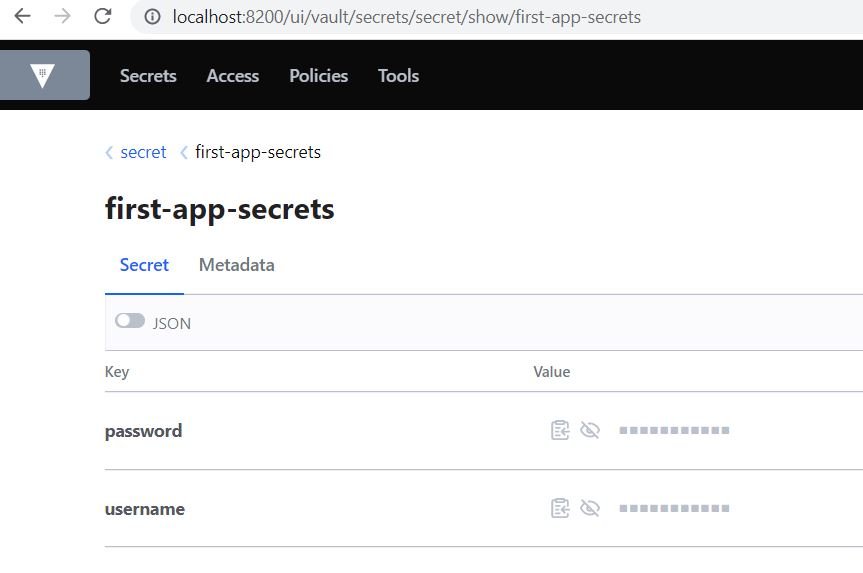Show List
Storing Updating and Removing Secrets from Vault
In this tutorial we will see how to add, retrieve, update, delete and remove secrets from Hashicorp using command line interface.
The Vault stores the secrets in key/value pairs. List of the key/value secret operations can be seen by running the command "vault kv -help"
mail2@sm15 MINGW64 ~
$ vault kv - help
Usage: vault kv <subcommand> [options] [args]
This command has subcommands for interacting with Vault's key-value
store. Here are some simple examples, and more detailed examples are
available in the subcommands or the documentation.
Create or update the key named "foo" in the "secret" mount with the value
"bar=baz":
$ vault kv put -mount=secret foo bar=baz
Read this value back:
$ vault kv get -mount=secret foo
Get metadata for the key:
$ vault kv metadata get -mount=secret foo
Get a specific version of the key:
$ vault kv get -mount=secret -version=1 foo
The deprecated path-like syntax can also be used, but this should be avoided
for KV v2, as the fact that it is not actually the full API path to
the secret (secret/data/foo) can cause confusion:
$ vault kv get secret/foo
Please see the individual subcommand help for detailed usage information.
Subcommands:
delete Deletes versions in the KV store
destroy Permanently removes one or more versions in the KV store
enable-versioning Turns on versioning for a KV store
get Retrieves data from the KV store
list List data or secrets
metadata Interact with Vault's Key-Value storage
patch Sets or updates data in the KV store without overwriting
put Sets or updates data in the KV store
rollback Rolls back to a previous version of data
undelete Undeletes versions in the KV store
Creating Key/Value secrets
To create the secret, we have to supply the path where secrets are to be stored and key/value pairs. put command is used to add or update the secrets. Here is sample command. In this command, we are providing the path to store the secrets as "secret/first-app-secrets". username and passwords are key value pairs here that are going to be stored at the secret's path.
mail2@sm15 MINGW64 ~ $ vault kv put secret/first-app-secrets username=mytopsecretusername password=mytopsecretpassword ======== Secret Path ======== secret/data/first-app-secrets ======= Metadata ======= Key Value --- ----- created_time 2022-12-25T23:59:27.1182955Z custom_metadata <nil> deletion_time n/a destroyed false version 1
Updating the secret
Put command can also be used to update the values at the secret's path.
If any updates are done to the values at secret path, Vault creates a new version. Here is the command that will update the values at the path created earlier. Here we see that the version number has been updated to 2
mail2@sm15 MINGW64 ~ $ vault kv put secret/first-app-secrets username=mytopsecretusername password=mynewtopsecretpassword ======== Secret Path ======== secret/data/first-app-secrets ======= Metadata ======= Key Value --- ----- created_time 2022-12-26T00:05:12.8519398Z custom_metadata <nil> deletion_time n/a destroyed false version 2
Retrieve Secrets
Get command is used to retrieve the secrets.
mail2@sm15 MINGW64 ~ $ vault kv get secret/first-app-secrets ======== Secret Path ======== secret/data/first-app-secrets ======= Metadata ======= Key Value --- ----- created_time 2022-12-26T00:05:12.8519398Z custom_metadata <nil> deletion_time n/a destroyed false version 2 ====== Data ====== Key Value --- ----- password mynewtopsecretpassword username mytopsecretusername
Version number can be provided to get the secrets from specific version of the path
mail2@sm15 MINGW64 ~ $ vault kv get -version=1 secret/first-app-secrets ======== Secret Path ======== secret/data/first-app-secrets ======= Metadata ======= Key Value --- ----- created_time 2022-12-25T23:59:27.1182955Z custom_metadata <nil> deletion_time n/a destroyed false version 1 ====== Data ====== Key Value --- ----- password mytopsecretpassword username mytopsecretusername
Field name can be specified to retrieve the specific field secret.
mail2@sm15 MINGW64 ~ $ vault kv get -version=1 -field=password secret/first-app-secrets mytopsecretpassword
The stored secrets can also be viewed from the Vault UI:

Removing Secrets from Vault
There are two ways to remove the secrets from the Vault path. Delete command can be reverted meaning that secret deleted from a path can be brought back using "undelete" command. Destroy command permanently removes the secret from the path.
Deleting the secrets from the path
mail2@sm15 MINGW64 ~ $ vault kv delete secret/first-app-secrets Success! Data deleted (if it existed) at: secret/data/first-app-secrets
Now if we try to retrieve the secrets we only get the meta data
mail2@sm15 MINGW64 ~ $ vault kv get secret/first-app-secrets ======== Secret Path ======== secret/data/first-app-secrets ======= Metadata ======= Key Value --- ----- created_time 2022-12-26T00:05:12.8519398Z custom_metadata <nil> deletion_time 2022-12-26T02:17:22.6706911Z destroyed false version 2
Undeleting the deleted secrets: Versions to be restored is to be provided using versions flag. The provided version number and previous versions get restored.
mail2@sm15 MINGW64 ~ $ vault kv undelete -versions=2 secret/first-app-secrets Success! Data written to: secret/undelete/first-app-secrets
We can now retrieve the secrets
mail2@sm15 MINGW64 ~ $ vault kv get secret/first-app-secrets ======== Secret Path ======== secret/data/first-app-secrets ======= Metadata ======= Key Value --- ----- created_time 2022-12-26T00:05:12.8519398Z custom_metadata <nil> deletion_time n/a destroyed false version 2 ====== Data ====== Key Value --- ----- password mynewtopsecretpassword username mytopsecretusername
Destroying the secrets from the path: Destroy command permanent removed the secrets from the path and secrets can not be undeleted. Destroy command requires versions flag.
mail2@sm15 MINGW64 ~ $ vault kv destroy -versions=2 secret/first-app-secrets Success! Data written to: secret/destroy/first-app-secrets
After this execution version 2 is removed but version 1 can still be retrieved.
mail2@sm15 MINGW64 ~ $ vault kv get -version=2 -field=password secret/first-app-secrets No data found at secret/data/first-app-secrets mail2@sm15 MINGW64 ~ $ vault kv get -version=1 -field=password secret/first-app-secrets mytopsecretpassword
Leave a Comment